Threats of Longline Fishing to Global Albatross Diversity
Abstract
:Simple Summary
Abstract
1. Introduction
2. Materials and Methods
2.1. Theoretical Framework
2.2. Hypotheses
2.2.1. Dependent Variable
2.2.2. Independent Variable
2.2.3. Control Variables
2.3. Statistical Analysis
3. Results
4. Discussion
4.1. Limitations
4.2. Policy Implications
4.3. Reducing IUU Fishing
5. Conclusions
Author Contributions
Funding
Institutional Review Board Statement
Informed Consent Statement
Data Availability Statement
Conflicts of Interest
Abbreviations
| CPT | Crime pattern theory |
| CRAAVED | Concealable, removable, accessible, abundant, valuable, enjoyable, disposable |
| FOC | Flags of convenience |
| ITWF | International Transport Workers’ Federation |
| IUCN | International Union for Conservation of Nature |
| IUU | Illegal, unreported, and unregulated fishing |
| RFMO | Regional fisheries management organization |
Appendix A. Data on 22 Albatross Species
| Common Name | Latin Name | IUCN Red List Status | Impact Severity | ||
|---|---|---|---|---|---|
| 2016 | Fishing | Domestic Cats | Rats | ||
| Amsterdam Albatross | Diomedea amsterdamensis | CR | 4 | 1 | 0 |
| Tristan Albatross | Diomedea dabbenena | CR | 4 | 0 | 3 |
| Waved Albatross | Phoebastria irrorata | CR | 3 | 0 | 0 |
| Atlantic Yellow-nosed Albatross | Thalassarche chlororhynchos | EN | 3 | 0 | 0 |
| Black-browed Albatross | Thalassarche melanophrys | NT | 4 | - | 0 |
| Indian Yellow-nosed Albatross | Thalassarche carteri | EN | 4 | 0 | 0 |
| Northern Royal Albatross | Diomedea sanfordi | EN | 2 | 1 | - |
| Sooty Albatross | Phoebetria fusca | EN | 3 | 2 | 2 |
| Antipodean Albatross | Diomedea antipodensis | VU | - | - | 0 |
| Black-footed Albatross | Phoebastria nigripes | NT | 3 | 1 | 2 |
| Campbell Albatross | Thalassarche impavida | VU | 0 | 0 | 0 |
| Chatham Albatross | Thalassarche eremita | VU | 0 | 0 | 0 |
| Grey-headed Albatross | Thalassarche chrysostoma | VU | 4 | 0 | 0 |
| Salvin’s Albatross | Thalassarche salvini | VU | 1 | 0 | 0 |
| Short-tailed Albatross | Phoebastria albatrus | VU | 2 | 0 | 2 |
| Southern Royal Albatross | Diomedea epomophora | VU | 3 | 0 | 0 |
| Wandering Albatross | Diomedea exulans | VU | 4 | 2 | 0 |
| Buller’s Albatross | Thalassarche bulleri | NT | 0 | 0 | 0 |
| Laysan Albatross | Phoebastria immutabilis | NT | 3 | 0 | 1 |
| Light-mantled Albatross | Phoebetria palpebrata | NT | 3 | - | 0 |
| Shy Albatross | Thalassarche cauta | NT | - | 0 | 0 |
| White-capped Albatross | Thalassarche steadi | NT | 2 | 0 | 0 |
References
- Tuck, G.N.; Polacheck, T.; Bulman, C.M. Spatio-temporal trends of longline fishing effort in the Southern Ocean and implications for seabird bycatch. Biol. Conserv. 2003, 114, 1–27. [Google Scholar] [CrossRef]
- Gandini, P.; Frere, E. Spatial and temporal patterns in the by-catch of seabirds in the Argentinian long-line fishery. Fish. Bull. 2003, 104, 482–485. [Google Scholar]
- Croxall, J.P.; Butchart, S.H.M.; Lascelles, B.; Stattersfield, A.J.; Sullivan, B.; Symes, A.; Taylor, P. Seabird conservation status, threats and priority actions: A global assessment. Bird Conserv. Int. 2012, 22, 1–34. [Google Scholar] [CrossRef] [Green Version]
- Huang, H. By-catch of high sea long-line fisheries and measures taken by Taiwan: Actions and challenges. Mar. Policy 2011, 35, 712–720. [Google Scholar] [CrossRef]
- Gilman, E. References on Seabird by-Catch in Long-Line Fisheries; Blue Ocean Institute: Honolulu, HI, USA, 2004. [Google Scholar]
- Anderson, O.R.J.; Small, C.J.; Croxall, J.P.; Dunn, E.K.; Sullivan, B.J.; Yates, O.; Black, A. Global seabird by-catch in long-line fisheries. Endanger. Species Res. 2011, 14, 91–106. [Google Scholar] [CrossRef] [Green Version]
- Gales, R.; Brothers, N.; Reid, T. Seabird mortality in the Japanese tuna long-line fishery around Australia, 1988–1995. Biol. Conserv. 1998, 86, 37–56. [Google Scholar] [CrossRef]
- Gilman, E. Marine Matters Seabird Mortality in North Pacific Longline Fisheries. Endanger. Species 2003, 20, 36. [Google Scholar]
- Lewison, R.L.; Crowder, L.B.; Read, A.J.; Freeman, S.A. Understanding impacts of fisheries by-catch on marine megafauna. Trends Ecol. Evol. 2004, 19, 598–604. [Google Scholar] [CrossRef]
- Small, C.J. Regional Fisheries Management Organizations: Their Duties and Performance in Reducing by-Catch of Albatrosses and Other Species; Birdlife International: Cambridge, UK, 2005. [Google Scholar]
- Nel, D.C.; Taylor, F.E. Globally Threatened Seabirds at Risk from Long-Line Fishing: International Conservation Re-Sponsibilities; Birdlife International Seabird Conservation Program: Cambridge, UK, 2003. [Google Scholar]
- Weimerskirch, H.; Brothers, N.; Jouventin, P. Population dynamics of wandering albatross Diomedea exulans and Amsterdam albatross D. amsterdamensis in the Indian Ocean and their relationships with long-line fisheries: Conservation implications. Biol. Conserv. 1997, 79, 257–270. [Google Scholar] [CrossRef]
- Croxall, J.P.; Prince, P.A. Potential interactions between wandering albatrosses and long-line fisheries for Patagonian toothfish at South Georgia. CCAMLR Sci. 1996, 3, 101–110. [Google Scholar]
- Pott, C.; Wiedenfeld, D.A. Information gaps limit our understanding of seabird bycatch in global fisheries. Biol. Conserv. 2017, 210, 192–204. [Google Scholar] [CrossRef]
- Petrossian, G.A.; de By, R.; Clarke, R.V. Illegal long-line fishing and albatross declines. Oryx 2016, 52, 336–345. [Google Scholar] [CrossRef] [Green Version]
- EJF. Lowering the Flag—Ending the Use of Flags of Convenience by Pirate Fishing Vessels; Environmental Justice Foundation: London, UK, 2009. [Google Scholar]
- UNODC (United Nations Office on Drugs and Crime). Transnational Organized Crime in The Fishing Industry; United Nations: New York, NY, USA, 2011; Available online: https://www.unodc.org/documents/human-trafficking/Issue_Paper_-_TOC_in_the_Fishing_Industry.pdf (accessed on 2 January 2021).
- George, R. Flying the Flag, Fleeing the State. The New York Times. 24 April 2011. Available online: www.nytimes.com/2011/04/25/opinion/25george.html (accessed on 10 February 2022).
- Petrossian, G.A.; Sosnowski, M.; Miller, D.; Rouzbahani, D. Flags for sale: An empirical assessment of flag of convenience desirability to foreign vessels. Mar. Policy 2020, 116, 103937. [Google Scholar] [CrossRef]
- Wortley, R.; Mazerolle, L. (Eds.) Environmental Criminology and Crime Analysis; Willan: New York, NY, USA, 2008. [Google Scholar]
- Andresen, M.A.; Malleson, N. Crime seasonality and its variations across space. Appl. Geogr. 2013, 43, 25–35. [Google Scholar] [CrossRef]
- Ratcliffe, J.H.; Rengert, G.F. Near-Repeat Patterns in Philadelphia Shootings. Secur. J. 2008, 21, 58–76. [Google Scholar] [CrossRef]
- Farrell, G.; Pease, K. Preventing Repeat and Near Repeat Crime Concentrations. In Handbook of Crime Prevention and Community Safety; Taylor & Francis: Abingdon, UK, 2017; pp. 143–156. [Google Scholar]
- Fagan, A.A.; Mazerolle, P. Repeat Offending and Repeat Victimization: Assessing Similarities and Differences in Psychosocial Risk Factors. Crime Delinq. 2008, 57, 732–755. [Google Scholar] [CrossRef]
- Lemieux, A.M.; Clarke, R.V. The International Ban on Ivory Sales and its Effects on Elephant Poaching in Africa. Br. J. Criminol. 2009, 49, 451–471. [Google Scholar] [CrossRef]
- Pires, S.F.; Clarke, R.V. Sequential Foraging, Itinerant Fences and Parrot Poaching in Bolivia. Br. J. Criminol. 2011, 51, 314–335. [Google Scholar] [CrossRef]
- Pires, S.; Clarke, R.V. Are Parrots CRAVED? An Analysis of Parrot Poaching in Mexico. J. Res. Crime Delinq. 2011, 49, 122–146. [Google Scholar] [CrossRef]
- Pires, S.F.; Olah, G.; Nandika, D.; Agustina, D.; Heinsohn, R. What drives the illegal parrot trade? Applying a criminological model to market and seizure data in Indonesia. Biol. Conserv. 2021, 257, 109098. [Google Scholar] [CrossRef]
- Petrossian, G.A. Preventing illegal, unreported and unregulated (IUU) fishing: A situational approach. Biol. Conserv. 2015, 189, 39–48. [Google Scholar] [CrossRef]
- Petrossian, G.A. A micro-spatial analysis of opportunities for IUU fishing in 23 Western African countries. Biol. Conserv. 2018, 225, 31–41. [Google Scholar] [CrossRef]
- Weekers, D.P.; Zahnow, R. Risky facilities: Analysis of illegal recreational fishing in the Great Barrier Reef Marine Park, Australia. Aust. N. Z. J. Criminol. 2018, 52, 368–389. [Google Scholar] [CrossRef]
- Weekers, D.; Petrossian, G.; Thiault, L. Illegal fishing and compliance management in marine protected areas: A situational approach. Crime Sci. 2021, 10, 1–14. [Google Scholar] [CrossRef]
- Skidmore, A. Using crime script analysis to elucidate the details of Amur tiger poaching in the Russian Far East. Crime Sci. 2021, 10, 16. [Google Scholar] [CrossRef]
- Viollaz, J.S.; Thompson, S.T.; Petrossian, G.A. When Human–Wildlife Conflict Turns Deadly: Comparing the Situational Factors That Drive Retaliatory Leopard Killings in South Africa. Animals 2021, 11, 3281. [Google Scholar] [CrossRef]
- Marteache, N.; Pires, S.F. Choice Structuring Properties of Natural Resource Theft: An Examination of Redwood Burl Poaching. Deviant Behav. 2019, 41, 311–328. [Google Scholar] [CrossRef]
- Brantingham, P.J.; Brantingham, P.L. Environment, routine and situation: Toward a pattern theory of crime. Adv. Criminol. Theory 1993, 5, 259–294. [Google Scholar]
- Petrossian, G.A.; Clarke, R.V. Explaining and Controlling Illegal Commercial Fishing: An Application of the CRAVED Theft Model. Br. J. Criminol. 2013, 54, 73–90. [Google Scholar] [CrossRef]
- Birdlife International. Birdlife is Working with Regional Fisheries Management Organizations to Reduce Albatross Declines. 2022. Available online: http://datazone.birdlife.org/home (accessed on 15 September 2020).
- IUCN. The IUCN Red List of Threatened Species; IUCN: Cambridge, UK, 2016. [Google Scholar]
- Seabird Bycatch Working Group. Workshop. 2019. Available online: https://ebrc.org/wp-content/uploads/2019/08/NSTC-Workshop-Goals.pdf (accessed on 15 September 2020).
- Warner-Kramer, D. Control begins at home: Tackling flags of convenience and IUU fishing. Gold. Gate UL Rev. 2004, 34, 497. [Google Scholar]
- Ford, J.H.; Wilcox, C. Shedding light on the dark side of maritime trade–A new approach for identifying countries as flags of convenience. Mar. Policy 2019, 99, 298–303. [Google Scholar] [CrossRef]
- Miller, D.D.; Sumaila, U.R. Flag use behavior and IUU activity within the international fishing fleet: Refining definitions and identifying areas of concern. Mar. Policy 2014, 44, 204–211. [Google Scholar] [CrossRef]
- NASA Earth Observations. Sea Surface Salinity. Available online: https://neo.gsfc.nasa.gov/view.php?datasetId=AQUARIUS_SSS_M (accessed on 2 January 2021).
- National Centers for Environmental Information. Available online: https://www.ncdc.noaa.gov/sotc/tropical-cyclones/202008 (accessed on 2 January 2021).
- Kroodsma, D.A.; Mayorga, J.; Hochberg, T.; Miller, N.A.; Boerder, K.; Ferretti, F.; Wilson, A.; Bergman, B.; White, T.D.; Block, B.A.; et al. Tracking the global footprint of fisheries. Science 2018, 359, 904–908. [Google Scholar] [CrossRef] [PubMed] [Green Version]
- NASA Earth Observations. Sea Surface Temperature. 2021. Available online: https://neo.gsfc.nasa.gov/view.php?datasetId=MYD28M (accessed on 2 January 2021).
- Gini, C. Measurement of Inequality of Incomes. Econ. J. 1921, 31, 124. [Google Scholar] [CrossRef]
- Anselin, L. Local Indicators of Spatial Association—LISA. Geogr. Anal. 1995, 27, 93–115. [Google Scholar] [CrossRef]
- Kurland, J.; Pires, S.F.; Marteache, N. The spatial pattern of redwood burl poaching and implications for preven-tion. For. Policy Econ. 2018, 94, 46–54. [Google Scholar] [CrossRef]
- Kibel, P. New Technology Reduces Harm to Marine Species. 2018. Available online: https://theecologist.org/2018/oct/19/new-technology-reduces-harm-marine-species (accessed on 15 September 2020).
- Phillips, R.; Gales, R.; Baker, G.; Double, M.; Favero, M.; Quintana, F.; Tasker, M.; Weimerskirch, H.; Uhart, M.; Wolfaardt, A. The conservation status and priorities for albatrosses and large petrels. Biol. Conserv. 2016, 201, 169–183. [Google Scholar] [CrossRef]

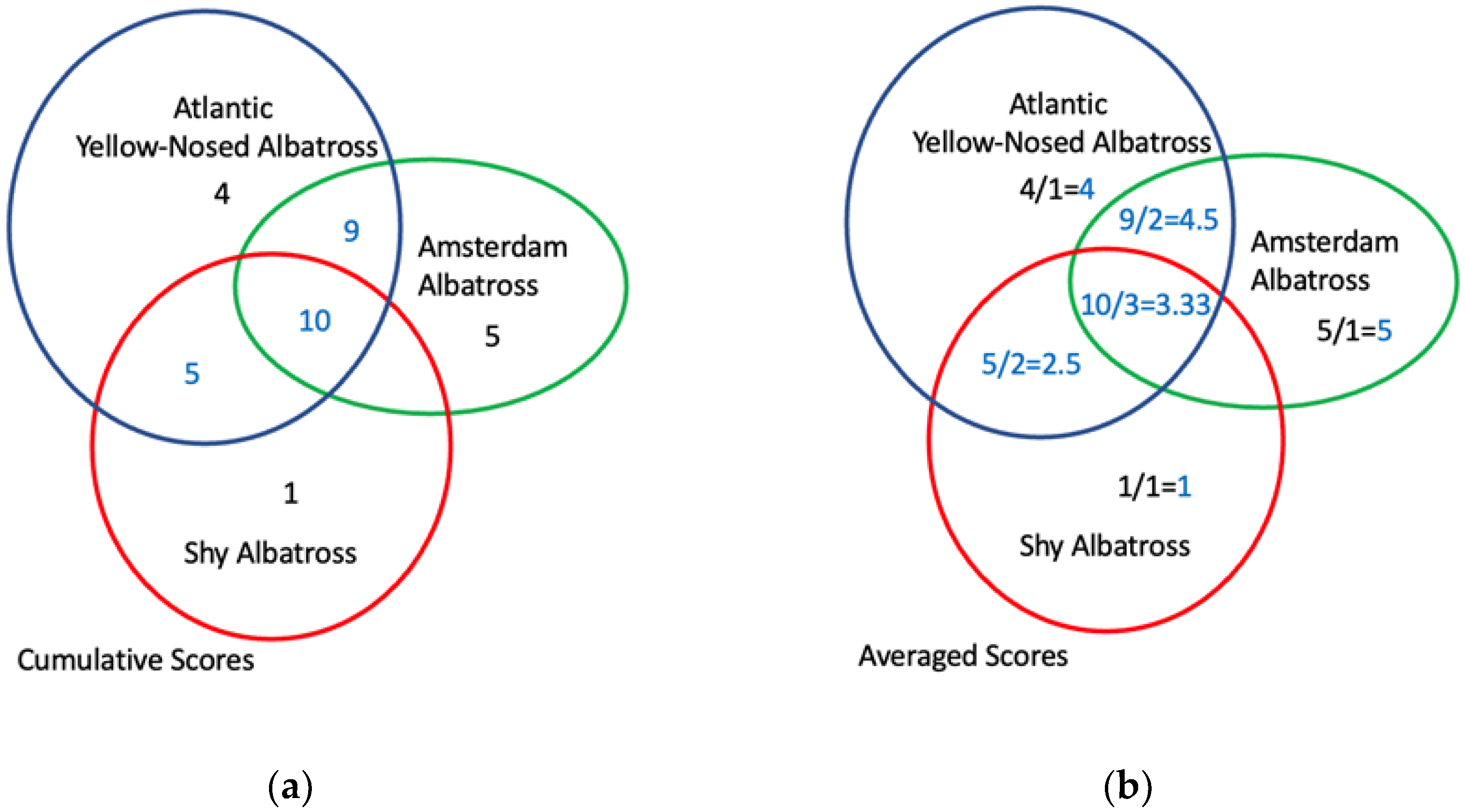
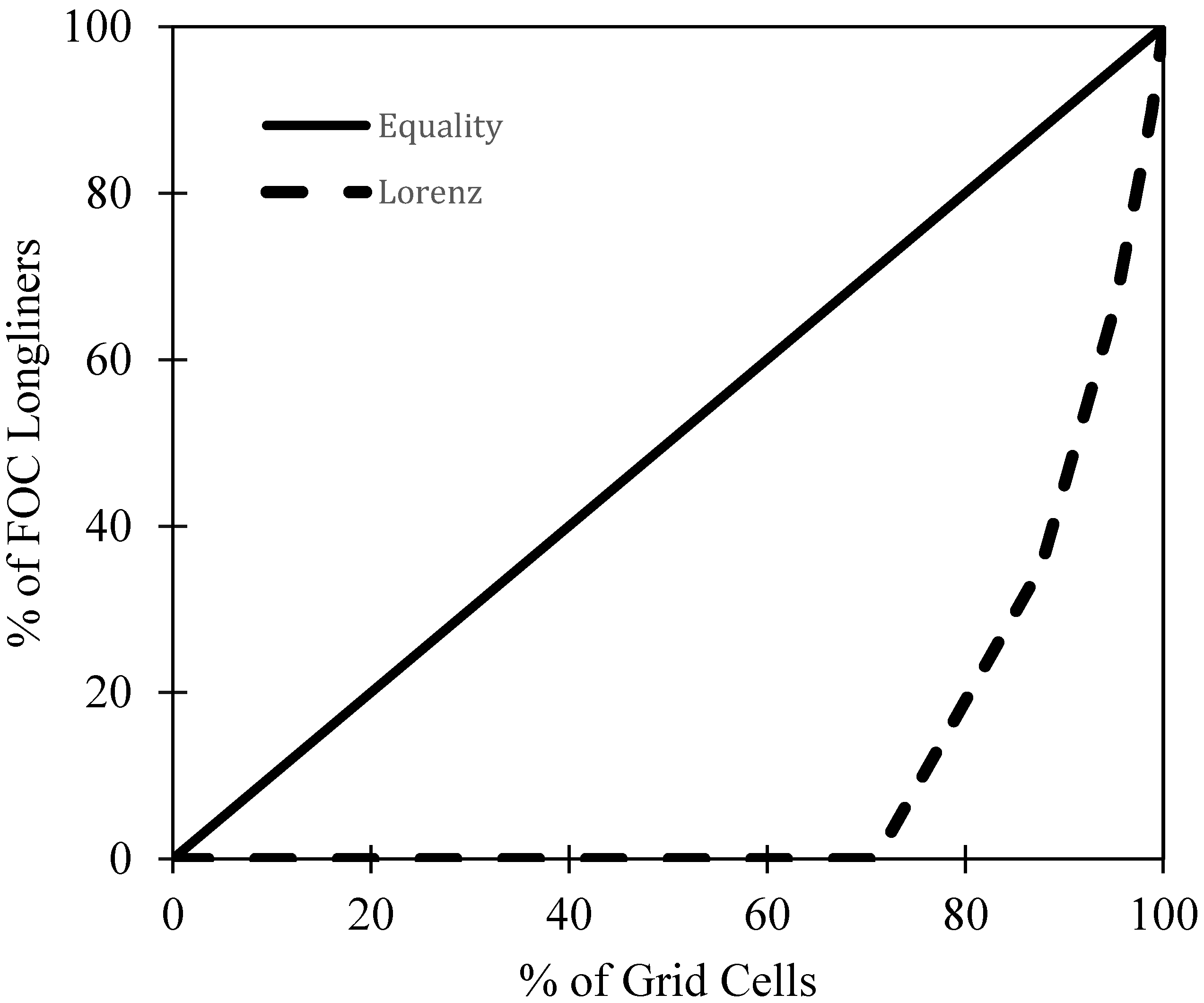
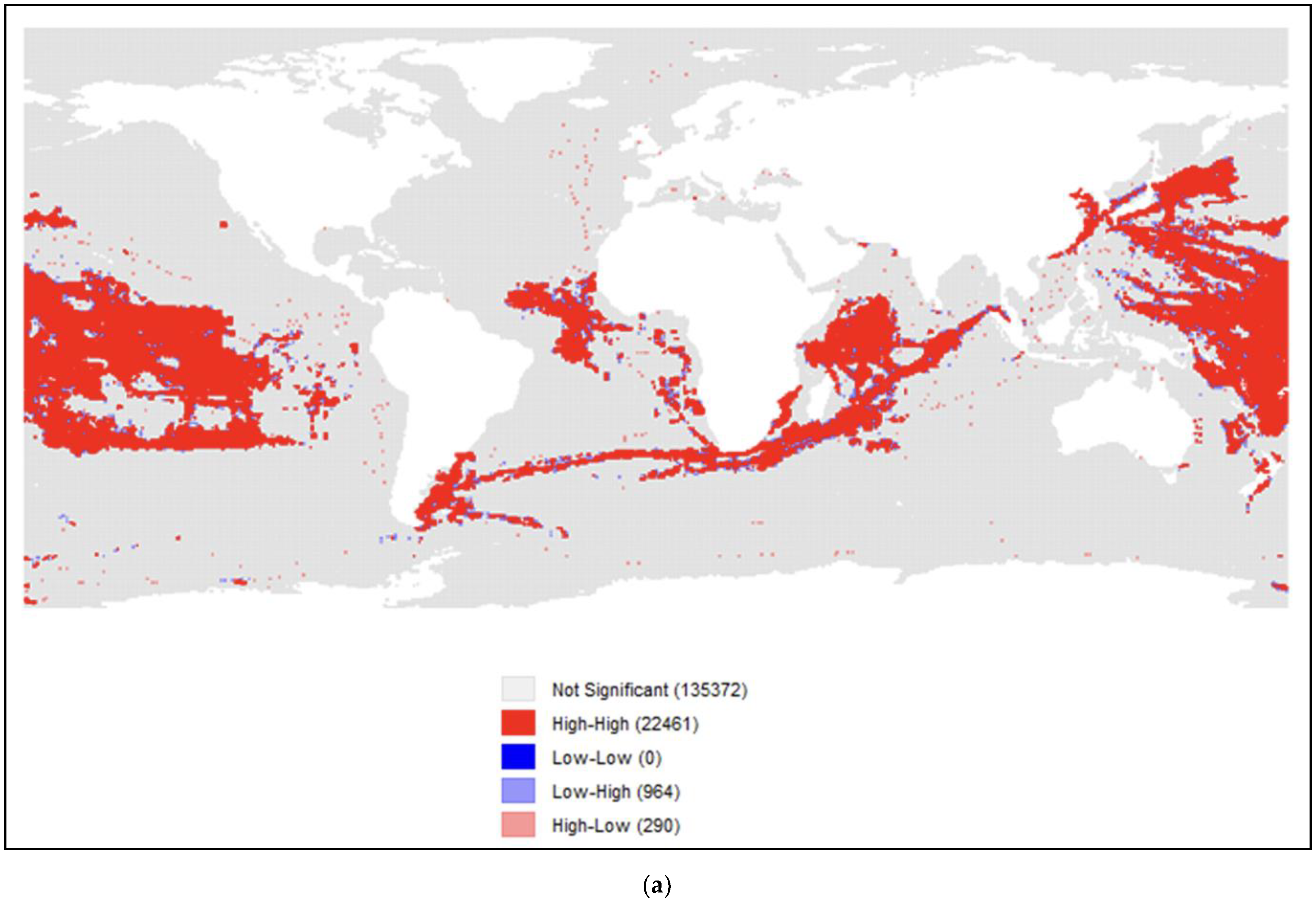
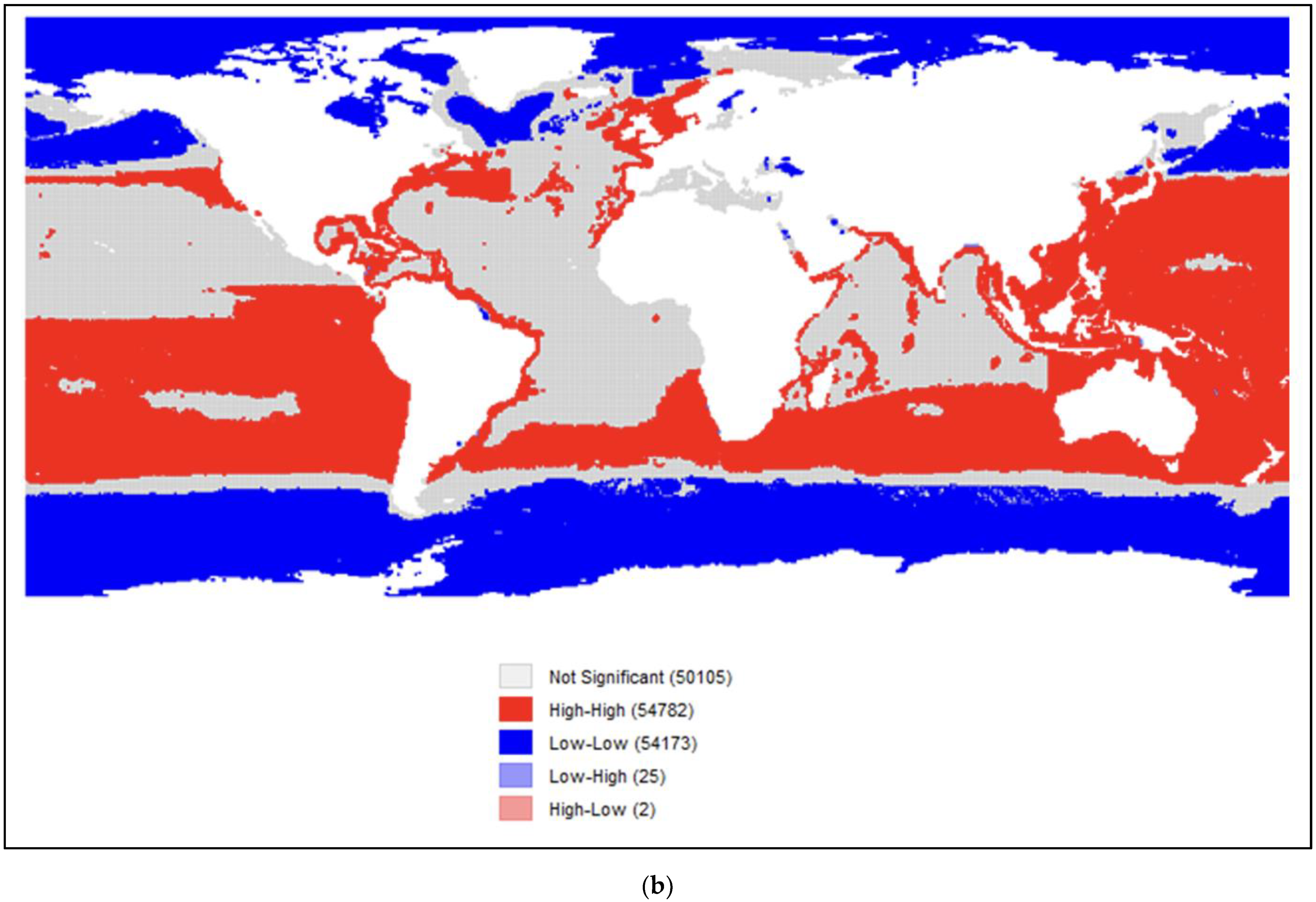
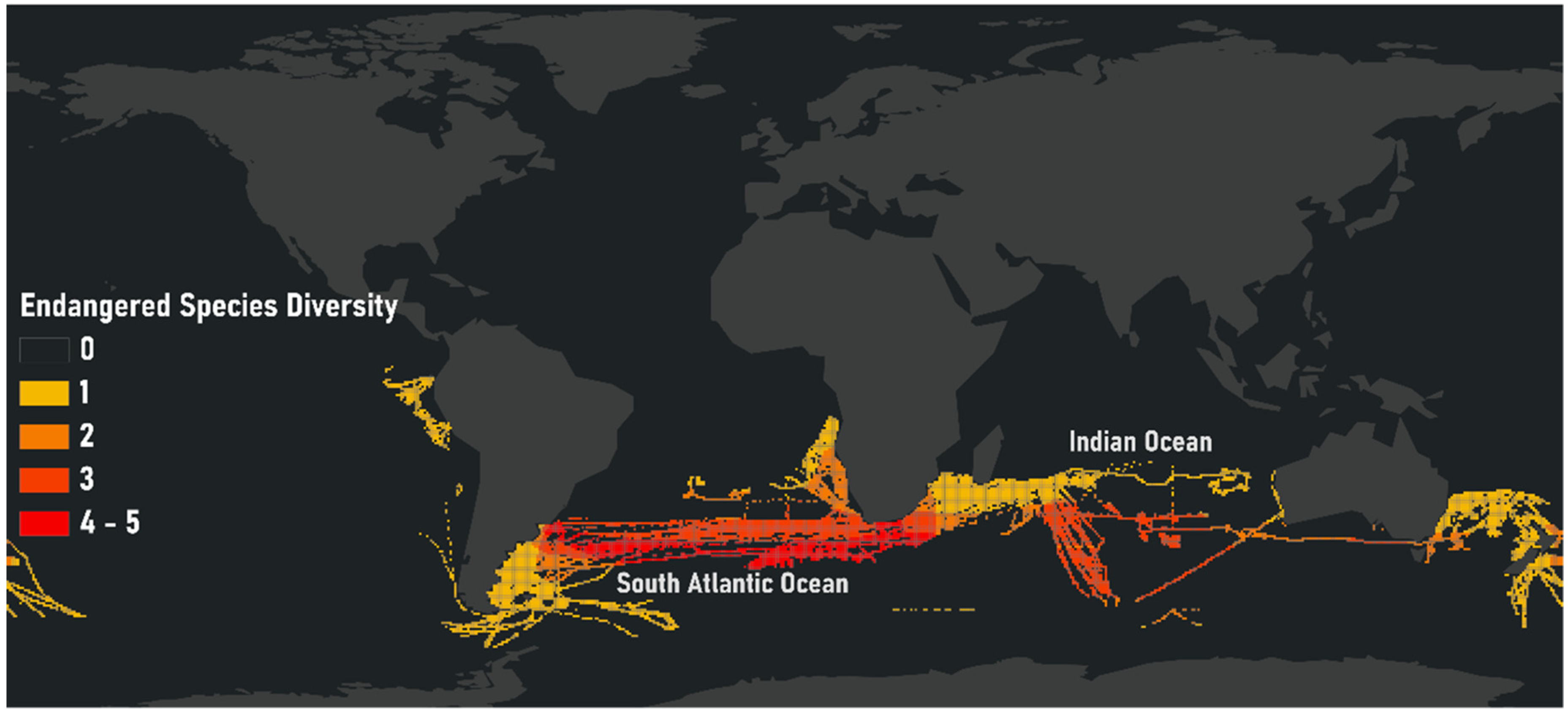
| Variable | N | Min | Max | Mean | SD |
|---|---|---|---|---|---|
| Outcome Measure | |||||
| Average albatross risk score (DV) | 159,087 | 0 | 5 | 0.94 | 0.87 |
| Independent Variables | |||||
| Cumulative risk score of CRAAVED fish | 159,087 | 0 | 155 | 36.24 | 24.99 |
| FOC-flagged longliners | 159,087 | 0 | 1 | -- | 0.454 |
| Other longliners | 159,087 | 0 | 1 | -- | 0.499 |
| Control Variables | |||||
| Sea surface salinity (SSS) | 159,087 | 0 | 0.04 | 0.03 | 0.01 |
| Sea surface temperature (SST) | 159,087 | −1.18 | 30.83 | 14.70 | 11.17 |
| B | SEB | β | |
|---|---|---|---|
| Intercept | 0.073 | 0.005 | - |
| FOC longliners present | 0.200 | 0.006 | −0.104 ** |
| Legal longliners present | −0.093 | 0.006 | −0.053 ** |
| Cumulative risk score of CRAAVED fish | 0.011 | 0.000 | −0.324 ** |
| SSS | 40.58 | 0.182 | −0.557 ** |
| Hurricane + Cyclone | −0.023 | 0.011 | −0.004 * |
| SST | −0.053 | 0.000 | −0.679 ** |
Publisher’s Note: MDPI stays neutral with regard to jurisdictional claims in published maps and institutional affiliations. |
© 2022 by the authors. Licensee MDPI, Basel, Switzerland. This article is an open access article distributed under the terms and conditions of the Creative Commons Attribution (CC BY) license (https://creativecommons.org/licenses/by/4.0/).
Share and Cite
Petrossian, G.A.; Pires, S.F.; Sosnowski, M.; Venu, P.; Olah, G. Threats of Longline Fishing to Global Albatross Diversity. Animals 2022, 12, 887. https://doi.org/10.3390/ani12070887
Petrossian GA, Pires SF, Sosnowski M, Venu P, Olah G. Threats of Longline Fishing to Global Albatross Diversity. Animals. 2022; 12(7):887. https://doi.org/10.3390/ani12070887
Chicago/Turabian StylePetrossian, Gohar A., Stephen F. Pires, Monique Sosnowski, Prabha Venu, and George Olah. 2022. "Threats of Longline Fishing to Global Albatross Diversity" Animals 12, no. 7: 887. https://doi.org/10.3390/ani12070887
APA StylePetrossian, G. A., Pires, S. F., Sosnowski, M., Venu, P., & Olah, G. (2022). Threats of Longline Fishing to Global Albatross Diversity. Animals, 12(7), 887. https://doi.org/10.3390/ani12070887






